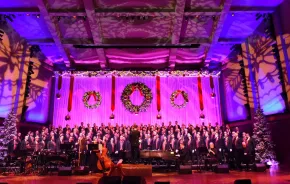 From the kiddies to the connoisseurs, there’s something for everyone at Pacific Northwest Ballet this weekend – but not all at the same time.
From the kiddies to the connoisseurs, there’s something for everyone at Pacific Northwest Ballet this weekend – but not all at the same time.
Pacific Northwest Ballet (PNB) company is performing a mixed repertory called Modern Masterpieces, while the Pacific Northwest Ballet School presents Hansel and Gretel. Both are excellent; neither is for everyone.
Modern Masterpieces is an aptly named collection of some of PNB’s most interesting works. Although the first two pieces are a good introduction to modern ballet, the second half is more challenging with its combination of nontraditional movement and inaccessible music. Ballet fans and orchestra nerds will love it, but younger kids and the uninitiated may prefer something else.
Including two intermissions, Modern Masterpieces lasts three hours. Almost everyone will recognize the music by Johann Sebastian Bach used for George Balanchine’s “Concerto Barocco.” This beautiful ballet is a great opener. The white-clad women of “Concerto Barocco” are replaced by men in black in the world premiere of Paul Gibson’s “Mozart Pieces.” Somewhat unusual for its focus on male dancers, “Mozart Pieces” remains conventionally pretty through its use of familiar music and movement.
During the first intermission, my 8 year-old and I talked about how dance doesn’t always tell a story. It can be a way of showing the music; dancers match their bodies to the sounds that the music makes. Because this is what children do, she made this leap easily, and enjoyed these first two pieces as much as I did.
 Ulysses Dove’s “Dancing on the Front Porch of Heaven,” set to music by Arvo Pärt, is completely unconventional. Subtitled “Odes to Love and Loss,” the piece’s stark white costumes and spotlights; alternately jerky and oblong movements; and severe score all communicate the feeling of wrongness that comes from losing a loved one. My daughter liked the “weird” movements, but the themes and the music were over her head.
Ulysses Dove’s “Dancing on the Front Porch of Heaven,” set to music by Arvo Pärt, is completely unconventional. Subtitled “Odes to Love and Loss,” the piece’s stark white costumes and spotlights; alternately jerky and oblong movements; and severe score all communicate the feeling of wrongness that comes from losing a loved one. My daughter liked the “weird” movements, but the themes and the music were over her head.
“Dancing on the Front Porch of Heaven” is unquestionably a masterpiece, but like many masterpieces, it is not for the beginner. I would recommend it for high school students, or perhaps arts-minded middle schoolers.
The final piece was Twyla Tharp’s “In the Upper Room,” set to music by Philip Glass. The splashes of red in the black and white costumes seemed extravagant after three monochromatic pieces. Tharp’s exuberant choreography that so carelessly mixes classical ballet movements with aerobics and acrobatics was especially refreshing after Doves’ gravitas. Jogging out of the smoke that obscured much of the stage, dancers casually flipped over and under each other before disappearing back into the smoke. My daughter, whose favorite phrase is, “Watch my cool trick!” would have loved the energy and athleticism of this piece. Unfortunately, Philip Glass was too much for her, and she fell asleep.
 On the hand, Pacific Northwest Ballet School’s Hansel and Gretel is the something else that younger audiences and those who don’t enjoy challenging modern pieces will crave. Bruce Wells, using music by Oscar Nedbal, created a ballet specifically for the uninitiated and especially for the very young. The hour-long performance is accompanied by an onstage narrator. Although I found the voice-over distracting from the music, my four-year-old understood immediately that this was the best story time ever and sat transfixed. She was thrilled when she realized that the dancers were all children and teenagers.
On the hand, Pacific Northwest Ballet School’s Hansel and Gretel is the something else that younger audiences and those who don’t enjoy challenging modern pieces will crave. Bruce Wells, using music by Oscar Nedbal, created a ballet specifically for the uninitiated and especially for the very young. The hour-long performance is accompanied by an onstage narrator. Although I found the voice-over distracting from the music, my four-year-old understood immediately that this was the best story time ever and sat transfixed. She was thrilled when she realized that the dancers were all children and teenagers.
The PNB School is one of the top professional ballet training programs in the country. Hansel and Gretel is simpler than the choreography you will see from PNB’s company, but the quality of the dancing will easily hold up against many smaller professional companies. Audiences will not feel like they are there just to support the kids.
Elaborate sets, ornate costumes, and a familiar, straight-forward story make it easy for even the youngest viewers to sit quietly for an hour. An audience full of families means that whispered questions and randomly timed applause are overlooked. Crafts and dance lessons in the lobby before the performance help make the event feel extra-special, and help keep kids occupied until the curtain bell. If your family is new to ballet, this is the perfect opportunity to see what you’ve been missing.
If you go ...
When: Modern Masterpieces: Thursday, March 21–Saturday, March 23 at 7:30 p.m; Sunday, March 24 at 1 p.m.
Hansel and Gretel: Friday, March 22 at 10:30 a.m. and Saturday, March 23 at 3:30 p.m.
Arrive early to allow time for parking, collecting booster seats, and getting settled.
Where: Marion Oliver McCaw Hall, 321 Mercer Street, on the north edge of Seattle Center.
Tickets: Tickets for Modern Masterpieces range from $28–$173. Tickets for Hansel and Gretel range from $25–$70. Every family member must have a ticket, but children’s tickets are slightly discounted for Hansel and Gretel. There are no bad seats at McCaw Hall — do not hesitate to buy the cheapest seats available.Tickets can be purchased online.
Parking: The Mercer Garage is connected to McCaw Hall by a sky bridge. Rates vary from $5–$15 depending on events at Seattle Center. Other pay lots in the neighborhood have similar pricing. Street parking is limited to 4 hours, and hard to come by. Consider taking the bus — look online to plan your route.
 About the author: Gemma Alexander is a Seattle-based writer and mother of two.
About the author: Gemma Alexander is a Seattle-based writer and mother of two.











